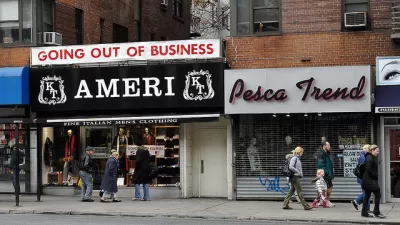For a city famous for high cost of living, incredible demand for housing, famous examples of gentrification, and political pressure to build, New York City is lagging behind the volumes of residential construction approved in comparable cities.
According to an article by Laura Kusisto and Eliot Brown, "the number of units authorized in New York City through building permits remains well below levels before the market crashed in late 2008, according to U.S. Census Bureau figures."
"In New York, permits for 17,995 new housing units were issued in 2013, slightly more than half the nearly 34,000 units authorized in 2008 and below the number approved for 2002."
Kusisto and Brown cite San Francisco, Boston, Washington D.C., and Seattle as cities that are issuing permits at pre-crash levels—San Francisco, in fact, issued almost twice as many permits in 2013 as it did in 2005.
The explanation for the sluggish building industry, according to real-estate analysts and developers mentioned in the article: "a combination of factors they say have made New York an increasingly inhospitable place to build housing."
Stephen Miller, writing for New York YIMBY, provides a different explanation than the traditional arguments of "high land costs, high construction costs, overuse of landmarking." Instead, Miller suggests we look " far beyond the gentrifying fringe" for the real cause of New York's tepid rebound. "Put simply," writes Miller, "New York City’s small builders have been nearly eradicated. The segment of the market that normally produces about half the city’s new building stock has all but vanished."
FULL STORY: Residential Construction in New York City Lags

Alabama: Trump Terminates Settlements for Black Communities Harmed By Raw Sewage
Trump deemed the landmark civil rights agreement “illegal DEI and environmental justice policy.”

Study: Maui’s Plan to Convert Vacation Rentals to Long-Term Housing Could Cause Nearly $1 Billion Economic Loss
The plan would reduce visitor accommodation by 25% resulting in 1,900 jobs lost.

Planetizen Federal Action Tracker
A weekly monitor of how Trump’s orders and actions are impacting planners and planning in America.

Waymo Gets Permission to Map SF’s Market Street
If allowed to operate on the traffic-restricted street, Waymo’s autonomous taxis would have a leg up over ride-hailing competitors — and counter the city’s efforts to grow bike and pedestrian on the thoroughfare.

Parklet Symposium Highlights the Success of Shared Spaces
Parklets got a boost during the Covid-19 pandemic, when the concept was translated to outdoor dining programs that offered restaurants a lifeline during the shutdown.

Federal Homelessness Agency Places Entire Staff on Leave
The U.S. Interagency Council on Homelessness is the only federal agency dedicated to preventing and ending homelessness.
Urban Design for Planners 1: Software Tools
This six-course series explores essential urban design concepts using open source software and equips planners with the tools they need to participate fully in the urban design process.
Planning for Universal Design
Learn the tools for implementing Universal Design in planning regulations.
Caltrans
Smith Gee Studio
Institute for Housing and Urban Development Studies (IHS)
City of Grandview
Harvard GSD Executive Education
Toledo-Lucas County Plan Commissions
Salt Lake City
NYU Wagner Graduate School of Public Service





























